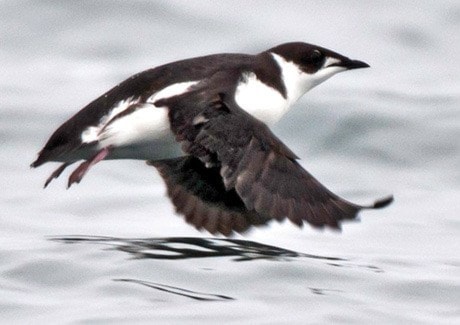Murrelet magic off ‘auk’ bay
By Jacques Sirois
I have never seen so many of this threatened seabird together before; 10 would have been a bonus, but 110? But wait, there are many more on the water and in the air over Mayor Channel, towards the Chain Islets and beyond.
By the time I paddled to Discovery Island, the Chatham Islands, Ten Mile Point and Cadboro Bay – thanks to calm conditions and great visibility – I counted about 550 marbled murrelets, 200 ancient murrelets and 50 other auks (including 40 pigeon guillemots, 10 common murres and one rhinoceros auklet) on that late January afternoon. Was this normal? I had to talk to an expert.
Thankfully, there is at least one marbled murrelet guru in Victoria: Gary Kaiser, a former colleague. “Over 500, in Oak Bay, really? Not aware of this,” he said. “This is newsworthy. Lots of krill – euphausids – I guess; not surprised, winter flocks often go unreported. Nobody’s out there.”
I soon learned that since 1989, Gary had reported flocks of more than 500 marbled murrelets only nine times; his largest included 798 birds. And those flocks were never this far south along our coast.
As for abundant krill here in winter, sure enough, swarms were quite obvious recently near the surface in the Chain Islets. At Ten Mile Point, my diving friend Yung Yip also reported “lots of it, like 50 shrimps per litre in Smuggler’s Cove.”
Surveys and statistics tell us that the Canadian population of this secretive and hard-to-study seabird includes only about 55,000 to 78,000 birds, with more – hundreds of thousands – in Alaska and relatively few south of British Columbia.
This means that Oak Bay, with its strong tidal currents where murrelets love to feed, is a noteworthy southern staging site for these tree-nesting auks. It is also noteworthy because of its “urban” location.
These small auks, roughly the size of a California quail, are nearly invisible from shore. Their black-and-white, winter plumage is unremarkable. They fly extremely fast and dive constantly. On the other hand, most of the birds I saw were busy courting and calling; love was in the air. Who would have thought Oak Bay was a romantic, winter destination for libidinous murrelets …?
What about their future? Their vulnerability to oil spills, fishing nets and logging is food for thought. They love to nest on big branches of large, old trees, way up there. What an unexpected story, I kept thinking later while standing at Cattle Point without seeing a single murrelet. Maybe we should rename Oak Bay Auk Bay!
Jacques Sirois is a retired wildlife biologist. He lives in Oak Bay and frequently kayaks around the waterfront.
